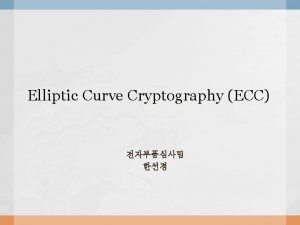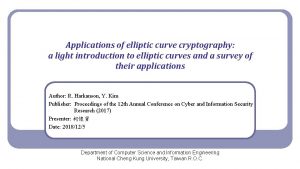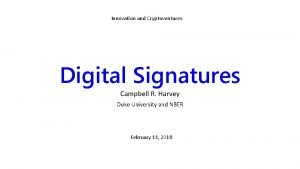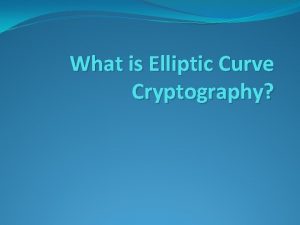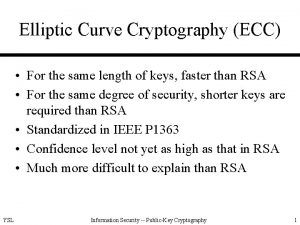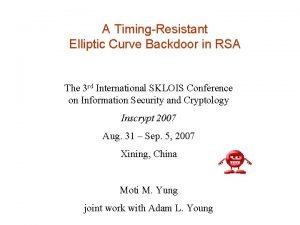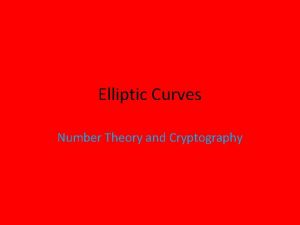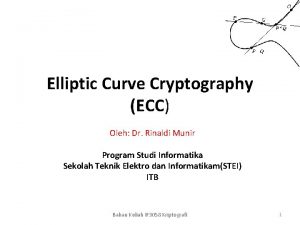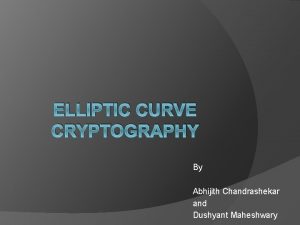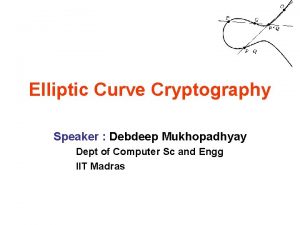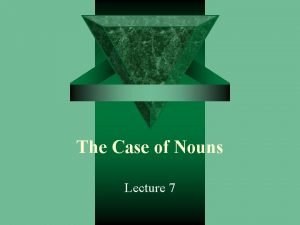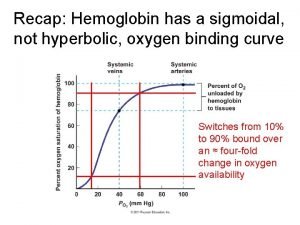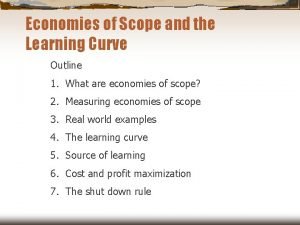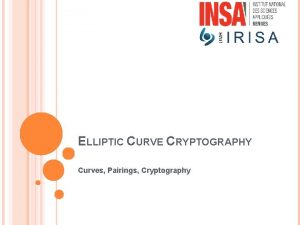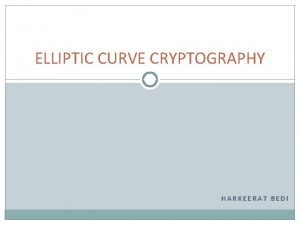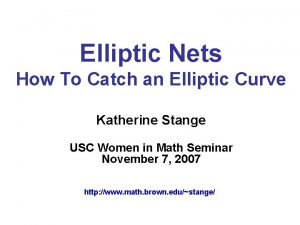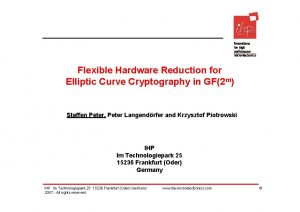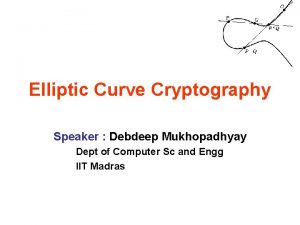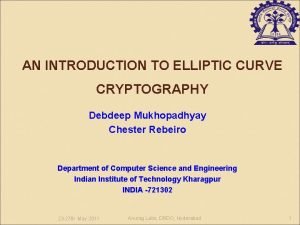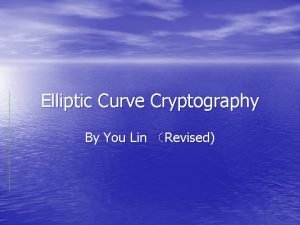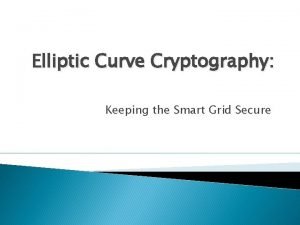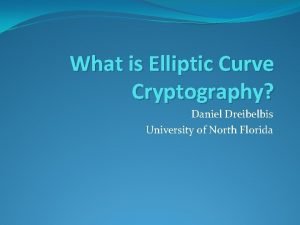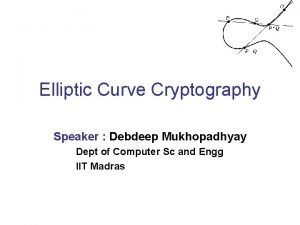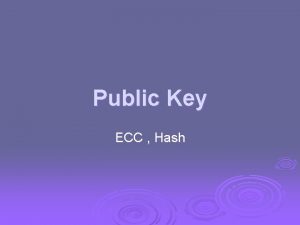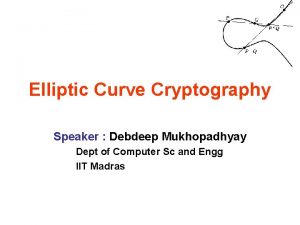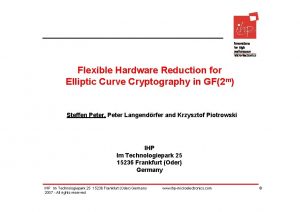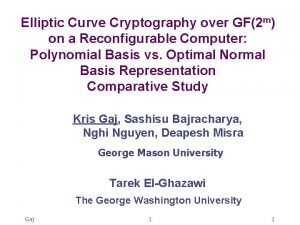What is Elliptic Curve Cryptography Outline Define the






































- Slides: 38

What is Elliptic Curve Cryptography?

Outline Define the Key Exchange Problem Define elliptic curves and their group structure Define elliptic curves mod p Define the Elliptic Curve Discrete Log Problem Elliptic curves for KEP Real life example

Basic Cryptography Alice wants to send a message to Bob. “Be sure to drink your Ovaltine. ” Eve is listening to any communication between Alice and Bob. Goal: Encrypt the message in a way that Alice and Bob know, but Eve does not.

Secret Decoder Ring Simple substitution cipher. Each letter is replaced by a letter k letters down the alphabet.

Secret Decoder Ring. Standard Caesar Code has k = 3. “Be sure to drink your Ovaltine. ” becomes “Eh vxuh wr gulqn brxu Rydowlqh. ” Bob decodes by removing k from each letter. The number k is called the key. Our SDR has 26 different keys.

Real Life SDR Our SDR has 26 different keys. In Real Life, we use an encryption method called AES (Advanced Encryption System). AES has 2128 different keys 2128 = 340, 282, 366, 920, 938, 463, 374, 607, 431, 768, 211, 456 That’s 340 undecillion. That’s a whole bunch of keys. A brute force key search is infeasible.

Key Exchange Problem Eve hears everything that Alice says to Bob and Bob says to Alice. If Alice and Bob try to agree on a key k, Eve will hear this also, and she will know the key. KEP: How can Alice and Bob agree on a key without Eve knowing its value?

Diffie-Hellman’s Idea Say that Alice, Bob, and Eve know how to multiply numbers, but they don’t know how to divide. Alice and Bob will agree on a number b. Then Alice will secretly pick a number p. A, while Bob will secretly pick a number p. B. Alice will compute the number q. A = bp. A, while Bob will compute the number q. B = bp. B. Alice will tell Bob the value of q. A, while Bob will tell Alice the value of q B. Alice will compute k = q. Bp. A, and Bob will compute k = q. Ap. B. This will be their key.

Example Alice and Bob agree to have b = 5. Alice picks p. A = 3, while Bob picks p. B = 2. Alice computes q. A = 15, and Bob computes q. B = 10. Alice and Bob exchange q. A and q. B. Alice computes k = 3*10 = 30, while Bob computer k = 2*15 = 30. They now use k = 30 with their SDR.

Can Eve Figure out k? Eve knows all shared values, which are: b, q. B, and q. A. She wants to figure out bp. Ap. B. She knows b, bp. A, and bp. B. To do this, she needs to be able to divide. But she does not know how to divide. In Real Life, multiplication and division are replaced with math problems that are “easy” to do, but really difficult to undo.

Elliptic Curves An elliptic curve is a curve of the form y 2 = x 3 + ax + b where 4 a 3 + 27 b 2 ≠ 0 Plus a point O at “infinity”. It is at the end of all vertical lines.

Examples

Group Structure P # Q

Group Structure: P + Q

Group Structure: P + P

Group Structure: P + O

Group Structure: Recap Using our definition of addition: P + Q is well defined P+Q=Q+P P + (Q + R) = (P + Q) + R P+O=P -P = P # (O # O)

Equations for Addition

Changing the Field Note that if the coefficients of the elliptic curve are in a particular field, and the coordinates of P and Q are in this field, then so is P + Q. If the field is real numbers, then we get the pictures we’ve seen. If the field is complex numbers, then we get modular forms. If the field is rational numbers, then we get algebraic number theory.

Mod p Define a mod b as the remainder when a is divided by b. 5 mod 3 = 2, 20 mod 7 = 6, 42 mod 7 = 0 Mod works nice with arithmetic. If p is a prime, we use the numbers {0, 1, 2, …, p-1}, and we can add, subtract, multiply, and divide. So we can do elliptic curves on the integers mod p.

Elliptic Curve mod p

Defining m. P 2 P = P + P 3 P = P + P m. P = P + … + P No matter how big m is, there is an efficient (quick) way to calculate m. P.

Example mod 541

Example mod 541

Example mod 541

Example mod 541

Example mod 541

Elliptic Curve Discrete Log Problem

ECDLP Begin with an elliptic curve mod p, let P be a point and let Q be a multiple of P. The ECDLP is to find the value of m such that Q = m. P. We can simply calculate 2 P, 3 P, 4 P, etc. But if p and m are large numbers, this could take trillions of years. Basically, we do not know of a fast way to solve ECDLP.

Key Exchange Alice and Bob want to agree on a key k. Alice and Bob agree on an elliptic curve, a large prime p (about 35 digits will do), and a point B on the curve. Eve knows the curve, the point, and the prime number. Alice secretly picks a large number p. A (about 20 digits will do). Bob secretly picks a large number p. B. Alice computes QA = p. AB. Bob computes QB = p. BB. They exchange the points QA and QB. Alice computes p. AQB = p. Ap. BB. Bob computes p. BQA = p. Bp. AB. Both use the x value of p. Ap. BB for the key k.

Example Let’s use y 2 = x 3 – x with p = 541, B = (10, 80). Alice picks p. A = 20. Bob picks p. B = 103. QA = 20 (10, 80) = (519, 241). QB = 103 (10, 80) = (85, 345). When Alice gets QB, she finds 20 QB = (353, 158). When Bob gets QA, he finds 103 QA = (353, 158). They both use K = 353 for their key.

Is it secure? Eve knows the elliptic curve, the prime p, the original point B, and the points QA = p. AB and QB = p. BB. To break, Eve needs to find p. A or p. B. To get either value, Eve needs to solve the ECDLP. No one knows how to do this in a reasonable length of time.

Why Use It? Most people use Diffie-Hellman, which uses DLP instead of ECDLP. There has been progress on solving DLP. There has been no progress on solving ECDLP. As far as we know, this is as difficult as a “Black-Box” log problem.

Addition Problem Mod p

Black Box Addition Problem

Microsoft’s DRM (digital right management)

Crypto’s Dirty Secret �Every form of public key cryptography or key exchange relies on our inability to solve a certain math problem quickly (factoring, DLP, ECDLP, SVP, etc). �It is still possible that these “hard math problems” have quick solutions. All we know is that no one has found a quick solution yet (or at least has admitted to this publicly). �Research Problem: Find a quick solution to the ECDLP (thus making ECC useless) OR prove that no quick solution exists (thus making every other form of crypto useless).

The End! Thanks! www. unf. edu/~ddreibel
 Elliptic curve cryptography
Elliptic curve cryptography Elliptic curve cryptography applications
Elliptic curve cryptography applications Elliptic curve cryptography
Elliptic curve cryptography Ecdlp
Ecdlp Cryptography
Cryptography Rsa backdoor
Rsa backdoor Elliptic curves number theory and cryptography
Elliptic curves number theory and cryptography Elliptic curve discrete logarithm problem
Elliptic curve discrete logarithm problem Elliptic curve
Elliptic curve Elliptic curve diffie hellman example
Elliptic curve diffie hellman example Elliptic genitive
Elliptic genitive Elliptic pde equation
Elliptic pde equation Hyperbolic oxygen chamber
Hyperbolic oxygen chamber S curve and j curve
S curve and j curve Balanced occlusion formula
Balanced occlusion formula Biotic potential and environmental resistance
Biotic potential and environmental resistance Curve outline
Curve outline Sentence outline example
Sentence outline example Define heating curve
Define heating curve Hình ảnh bộ gõ cơ thể búng tay
Hình ảnh bộ gõ cơ thể búng tay Slidetodoc
Slidetodoc Bổ thể
Bổ thể Tỉ lệ cơ thể trẻ em
Tỉ lệ cơ thể trẻ em Voi kéo gỗ như thế nào
Voi kéo gỗ như thế nào Glasgow thang điểm
Glasgow thang điểm Alleluia hat len nguoi oi
Alleluia hat len nguoi oi Các môn thể thao bắt đầu bằng tiếng bóng
Các môn thể thao bắt đầu bằng tiếng bóng Thế nào là hệ số cao nhất
Thế nào là hệ số cao nhất Các châu lục và đại dương trên thế giới
Các châu lục và đại dương trên thế giới Công của trọng lực
Công của trọng lực Trời xanh đây là của chúng ta thể thơ
Trời xanh đây là của chúng ta thể thơ Mật thư tọa độ 5x5
Mật thư tọa độ 5x5 Làm thế nào để 102-1=99
Làm thế nào để 102-1=99 Phản ứng thế ankan
Phản ứng thế ankan Các châu lục và đại dương trên thế giới
Các châu lục và đại dương trên thế giới Thể thơ truyền thống
Thể thơ truyền thống Quá trình desamine hóa có thể tạo ra
Quá trình desamine hóa có thể tạo ra Một số thể thơ truyền thống
Một số thể thơ truyền thống Cái miệng nó xinh thế chỉ nói điều hay thôi
Cái miệng nó xinh thế chỉ nói điều hay thôi
